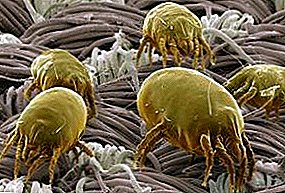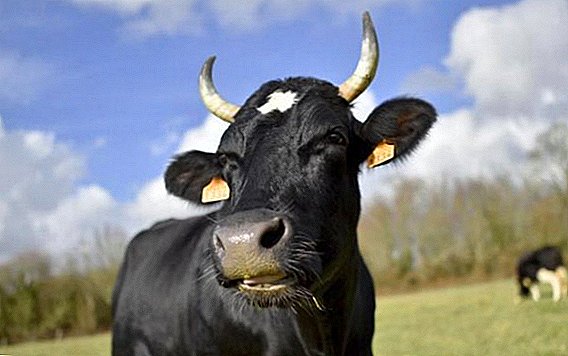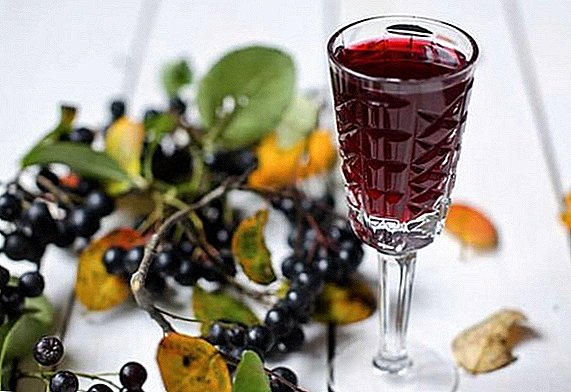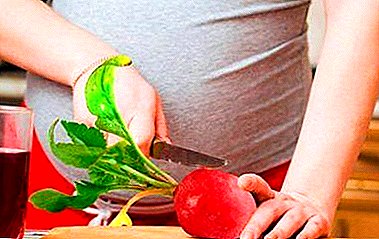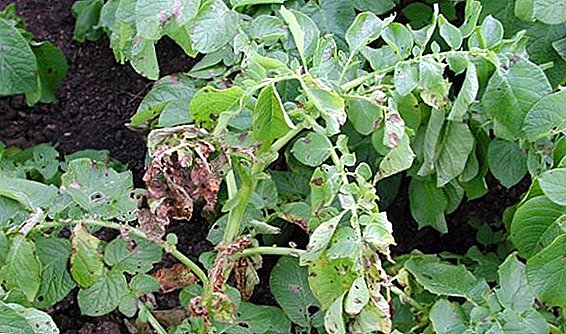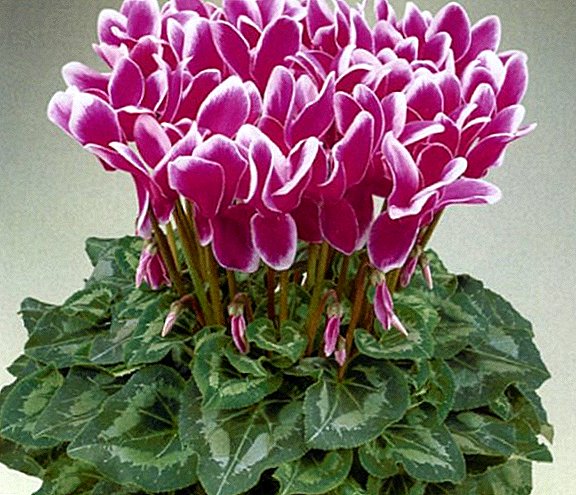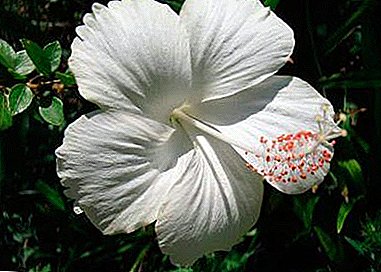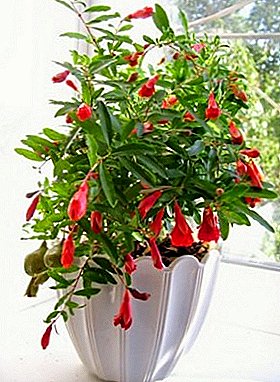
Dwarf pomegranate Carthage - flowering shrubs, not exceeding a meter in height.
The plant is imported from Carthage and is popular due to long flowering and small fruits.
Dwarf Pomegranate is a small copy of the usual pomegranate.
general description
 Dwarf pomegranate - a bush with a large number of oblong leaves and large red flowers. Leaf color - pale green.
Dwarf pomegranate - a bush with a large number of oblong leaves and large red flowers. Leaf color - pale green.
Cups look like a bouquet, in which wavy scarlet or pinkish petals are tightly collected.
There are plant species with yellow or white petals, but the most common is a dwarf pomegranate with red flowers. He belongs to the family Derbennikovs.
The rest period at the bush is short and begins only after the foliage has completely subsided. Some flowers still appear until the end of autumn, when the fruits ripen.
REFERENCE! Fruits look like rather large berries about seven centimeters in diameter. dark red or orange shades. Each fruit contains more than a thousand seeds in separate two-tier chambers.
Edible cover surrounds each of the seeds. Berries differ to taste from the usual pomegranate. Most often, this plant is used for decorative purposes, and in order for the fruits not to deplete the bush, they are often removed.
You can visually familiarize yourself with the Carthage dwarf pomegranate in the photo below:



Home care
Consider how to care for decorative pomegranate.
Care after purchase
Carthage dwarf pomegranate in room conditions prefers a very bright lighting and calmly withstands the absence of shading. If the light is not enough, it does not bloom. In the summer it is good to take it to an open place. It tolerates the plant and placement in the winter garden.
Pruning
Dwarf grenade calmly withstands pruning, and you can give it the desired shape by pinching and cutting off excess shoots. During the trimming procedure, you should not forget to leave the six main branches, which are the basis of the bush.
Learn more useful about trimming a dwarf grenade can be on the video below:
Watering
 In the heat and indoors with dry air, the bush requires spraying with water a little cooler.
In the heat and indoors with dry air, the bush requires spraying with water a little cooler.
If the grenade is placed in a cool place, this procedure is not necessary.
During the flowering period, watering should be reduced, but it is necessary to keep an eye on the leaves, as with a deficit of moisture the shrub will start dropping foliage.
After the pomegranate has faded, it should be watered more abundantlyin order for a large number of flowers to appear next year.
REFERENCE! During the rest period, a dwarf pomegranate should be watered as little as possible - once in two months. At the end of this period, watering is gradually increased. Topsoil should dry to a depth of about two centimeters.
If you wish to grow fruits, autumn watering should be very accurate, because with an excess of moisture they will begin crack.
Planting and soil
Despite the fact that the pomegranate tree in nature grows on poor dry soils, the home plant prefers a more nutritious soil with drainage.
For planting dwarf pomegranate, you can make such mixtures:
- in part of the land, humus and sand, a double part of clay-sod land;
- sand, turf, humus and leaf earth in equal volume. This mixture is well suited to young bushes;
- two parts of sand, peat and loam on one part;
- four parts of turf, two parts of leaf humus, a part of sand and the same amount of peat.
Transfer
 Transplanted young pomegranate bush Every year. After three years, transplantation is much less frequent: once every three years in the spring.
Transplanted young pomegranate bush Every year. After three years, transplantation is much less frequent: once every three years in the spring.
The pot is filled to a third with a drainage system and transplanted to the plant by transfer. Capacity is chosen most by a couple of centimeters in diameter, as the pomegranate bush does not like too wide pots.
In a close pot, much more intense flowering is observed than in a free one. For a plant at the age of five, a three-liter pot with a drainage hole is enough.
Growing a dwarf pomegranate seed
To grow a pomegranate bush with seeds, it’s best to buy them in specialty storesIn this case, the plant can bloom in the same year, and produce fruit in the second year.
IMPORTANT! You can use the seeds of the houseplant fruit. The seeds are selected the most ripe, they are washed and allowed to dry. Should be sown in April to a depth of five millimeters.
The soil prepared from the same proportions of sand and peat is regularly moistened. Air temperature for germination should be in the area 27 degrees When a pair of leaflets appear, seedlings should be transplanted in small tanks and ensure regular watering and warm air temperature. You can pinch several times.
Breeding
You can propagate dwarf grenades cuttings. They are taken from adult plants that produce fruits. The stalk must have 4-5 the kidneys. The lower part is planted at a small angle into a mixture of equal parts of sand and peat to a depth of about three centimeters.
Cuttings should be covered with a glass jar. The soil needs to be moistened, ventilated. Before planting, cuttings can be treated with a special rooting solution. Planted them in three months. Buds of young bushes better to pick off.
Temperature
 Since the dwarf garnet is heat-loving, it prefers the temperature above 20 degrees
Since the dwarf garnet is heat-loving, it prefers the temperature above 20 degrees
If the room temperature reaches 25 degrees and above, the plant can be taken out on the balcony. In a dry and hot microclimate, the bush will begin to lose foliage, which will affect the development of the plant itself.
When fruiting in autumn, the grenade provides a lower temperature. 12-17 degrees. From the end of autumn to March it is better to keep the bush at 10 degrees of heat. The lowest temperature that a pomegranate bush can endure is 6 degrees
Lighting
Dwarf pomegranate can be placed on any windows, except the north. In the summer, the plant is carried to the garden or to the balcony, gradually accustoming it to the open air. In early autumn, you should move the bush back to the room.
Benefit
All parts of the pomegranate plant have medicinal properties. The fruit contains a large number of organic bushes, as well as carbohydrates, proteins, fats. Fruits also contain phytoncides, tannin, folacin, and various trace elements. Fruit juice has antiseptic, diuretic, astringent properties.
Pomegranate flowers can be brewed as tea. Such a drink reminds the well-known hibiscus tea.
Diseases and pests
 The main pests of the dwarf pomegranate are scutes and whiteflies. If there are few pests, they can be harvested by hand. In case of mass lesions, special preparations should be used.
The main pests of the dwarf pomegranate are scutes and whiteflies. If there are few pests, they can be harvested by hand. In case of mass lesions, special preparations should be used.
With increased air dryness, a pomegranate bush may suffer from spider mite. To prevent its occurrence you need to spray the plant.
If a tick does appear, the plant is treated with a healing solution, pre-covering the soil with a plastic bag.
Sometimes on the plant may appear powdery mildew. When the pomegranate overflows, the foliage turns yellow. When the roots decay, it is better to transplant the shrub into dry soil, after getting rid of the rotten roots. In this case, well cut and crown.
Dwarf pomegranate is a beautifully flowering shrub that gives numerous juicy fruits with a pleasant taste. It blooms for a long time, peppering the whole plant with red flowers. The plant requires special care, including the observance of temperature conditions, watering, and sufficient light. Dwarf pomegranate decorates any room, and also looks great in gardens, on verandas and balconies.


